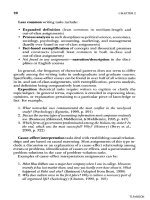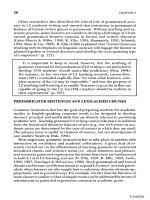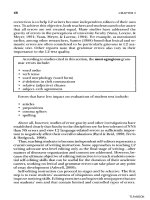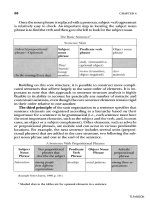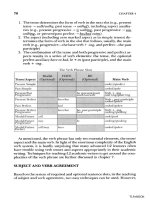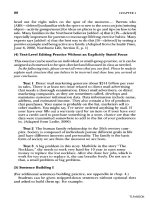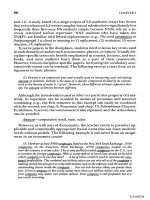2 academic legal writing
Bạn đang xem bản rút gọn của tài liệu. Xem và tải ngay bản đầy đủ của tài liệu tại đây (3.6 MB, 307 trang )
TABLE OF CONTENTS
FOREWORD, BY JUDGE ALEX KOZINSKI
INTRODUCTION
ACKNOWLEDGMENTS
I.
A.
B.
C.
FINDING WHAT TO WRITE ABOUT (THE CLAIM)
The Claim
1.
Your basic thesis
2.
The descriptive and the prescriptive parts of the thesis
Finding a Claim
1.
Finding a problem
2.
... in cases you've read for class, or in class discussions
3.
... in casebook questions
4.
... in issues left over or created by recent Supreme Court cases
5.
... in your work as a research assistant
6.
... by asking faculty members
7.
... by asking practicing lawyers
8.
... by checking Westlaw summaries of important recent cases
9.
... by paying attention to interesting newspaper articles
10.
... by reading legal blogs
11.
... by finding articles that aim to identify unanswered problems
12.
... by looking back at your experience as an extern or summer associate
13.
... by thinking back on your pre-law-school experiences
14.
... by attending symposia or panels
15.
Looking for future claims when you're in class
16.
Checking with your law school's faculty
17.
Keeping an open mind
18.
Identifying a tentative solution
Novelty
1.
Adding to the body of professional knowledge
2.
Making novelty through nuance
D.
Nonobviousness
E.
Utility
F.
1.
Focus on issues left open
2.
Apply your argument to other jurisdictions
3.
Incorporate prescriptive implications of your descriptive findings
4.
Consider making a more politically feasible proposal
5.
Avoid unnecessarily alienating your audience
Soundness: Prescriptive Claims
1.
Avoid excessive mushiness
2.
Avoid reliance on legal abstractions
3.
G.
Avoid procedural proposals that don't explain what substantive standards are to be
applied
Soundness: Historical and Empirical Claims
1.
Get advice from historians or empiricists
2.
Look for books and non-law articles
3.
Watch out for the historian's “false friends”
4.
Consider whether you're limiting your dataset in ways that undermine your
generalizations
5.
H.
I.
J.
Pay especially close attention to the Using Evidence Correctly chapter below (Part
XVII)
Selling Your Claim to Your Readers
Topics and Structures You Should Generally Avoid
1.
Articles that identify a problem but don't give a solution
2.
Case notes
3.
Single-state articles
4.
Articles that just explain what the law is
5.
Responses to other people's works
6.
Topics that the Supreme Court or Congress is likely to visit shortly
If You Must Write a Case Note
II.
TEST SUITES: MAKING PRESCRIPTIVE CLAIMS MORE SOUND
A.
What a Test Suite Is
B.
C.
III.
What You Might Find by Testing Your Proposal
1.
Identifying errors
2.
Identifying vagueness
3.
Finding surprising results
4.
Confirming the value of your proposal
Developing the Test Suite
1.
Identify what needs to be tested
2.
Use plausible test cases
3.
Include the famous precedents
4.
Include challenging cases
5.
Have a mix of cases
6.
Include cases that yield different results
7.
Include cases that appeal to different political perspectives
8.
Include cases that implicate different interests and policy arguments
WRITING THE INTRODUCTION
A.
The Role of the Introduction
B.
Show That There's a Problem, and Do So Concretely
C.
State the Claim
D.
Frame the Issue
E.
Do All This Quickly and Forcefully
F.
Some Ways to Start the Introduction
G.
IV.
1.
Start with the concrete questions you will try to answer
2.
Start with concrete examples
3.
Start with an engaging story
4.
Start with a concrete but vivid hypothetical that illustrates your point
5.
Start with an explanation of a controversy
6.
Start with an argument or conventional wisdom you want to rebut
Organize the Introduction as a Roadmap
WRITING THE “BACKGROUND” SECTION
A.
Focus on the Necessary Facts and Legal Rules
B.
Synthesize the Precedents; Don't Summarize Each One
V.
WRITING THE PROOF OF THE CLAIM
A.
Show Your Prescription Is Both Doctrinally Sound and Good Policy
B.
Be Concrete
C.
Use the Test Suite
D.
Confront the Other Side's Arguments, but Focus on Your Own
E.
Turn Problems to Your Advantage
F.
VI.
1.
Improve your argument
2.
Refine your claim
3.
Acknowledge uncertainty
4.
Acknowledge costs
Connect to Broader, Parallel, and Subsidiary Issues
1.
Make your article richer: Go beyond the basic claim
2.
Connections: Importing from broader debates
3.
Connections: Exporting to broader debates
4.
Connections: Importing from parallel areas
5.
Connections: Exporting to parallel areas
6.
Connections to subsidiary questions
7.
A cautionary note
THE CONCLUSION, AND AFTER THE CONCLUSION
A.
Write the Conclusion
B.
Rewrite the Introduction After the Draft Is Done
C.
VII.
1.
Rewrite the introduction in light of how your thinking has changed
2.
Note all your important and nonobvious discoveries
Decide What to Set Aside
FINISHING THE FIRST DRAFT, AND THE ZEROTH DRAFT
A.
Defeat Writer's Block by Skipping Around
B.
The Zeroth Draft
C.
As You Write, Use Subsection Headings
D.
Use a Table of Contents
E.
Note Down All Your Ideas
VIII.
TIPS ON RESEARCHING
A.
Identifying Sample Cases and Incidents
B.
Understanding the Law
1.
Get the big picture
2.
Get the details
3.
Find other works on the topic (the literature search)
4.
Identify how the articles you find are relevant
C.
Knowing When to Start Writing
D.
Digging Deeper into the Key Sources
E.
Digging Deeper into the Subject of the Legal Rules
F.
Talking to Your School's Reference Librarians
1.
If you've selected a topic
2.
If you're looking for a topic
3.
If you have questions about a specific task
4.
If you want bluebooking help
5.
Talk to the librarians with the right attitude
G.
Use Books and Treatises
H.
Use the Most Readable Printout Formats
I.
Search for Older Articles on HeinOnline
J.
Use ATLEAST, NOT W/, and SY,DI() Searches
K.
IX.
Researching Older Anglo-American Law
1.
Old treatises
2.
Old English cases
3.
Modern history books and articles
4.
Online databases
5.
Reporters that aren't on Westlaw and Lexis
6.
Watching out for past legal conventions
7.
Watching out for old citation formats
8.
Finding the right terms to search for
EDITING: GENERAL PRINCIPLES
A.
Go Through Many Drafts
B.
If You See No Red Marks on a Paragraph, Edit It Again
C.
If You Need to Reread Something to Understand It, Rewrite It
D.
Ask “Why?”
E.
Ask “Why Not?”
F.
Use Your Imaginary Friend (and Adversary)
G.
Use a Trusted Classmate (or Two)
H.
Read the Draft with “New Eyes”
I.
Conquer Your Fear
J.
There Are No Lazy Readers—Only Busy Readers
X.
EDITING: GETTING HELP FROM YOUR FACULTY ADVISOR
A.
Ask Your Advisor for Especially Detailed Advice
B.
Give Your Advisor an Already Closely Proofread Draft
C.
Give Your Advisor a Rough Draft as Quickly as Possible
D.
Treat Each Editing Comment as a Global Suggestion
XI.
WRITING: LOGICAL PROBLEMS TO WATCH FOR
A.
Categorical Assertions
B.
Insistence on Perfection
C.
False Alternatives
D.
Missing Pieces
E.
Criticisms That Could Apply to Everything
F.
Metaphors
G.
Undefined Terms
H.
Undefended Assertions, and “Arguably”/“Raises Concerns”
I.
Proofread, Proofread, Proofread
XII.
WRITING: PARAGRAPH-LEVEL PROBLEMS TO WATCH FOR
A.
Paragraphs Without a Common Theme
B.
Long Paragraphs
C.
Inadequate Connections Between Paragraphs
XIII.
A.
WRITING: SENTENCE/CLAUSE PROBLEMS TO WATCH FOR
Redundancy
B.
Unnecessary Introductory Clauses
C.
Other Unnecessary Phrases
D.
Needless Tangential Detail
XIV.
WRITING: WORD/PHRASE PROBLEMS TO WATCH FOR
A.
Legalese/Bureaucratese
B.
Nominalization
C.
Long Synonyms for Short Phrases (or for Single Words)
D.
Appendix I
E.
Misplaced Attempts at Dignity
F.
Unnecessary Abstractions
G.
Passive Voice
H.
Simple Word Choice Mistakes
I.
Inattentiveness to the Literal Meaning of a Word
J.
Errors Obscured by Intervening Words
K.
Inattentiveness to How Words Are Normally Used
L.
Failing to Listen to Your Doubts
M.
Using Needlessly Fancy Words
N.
Tip: Read a Usage Guide
O.
Clichés
P.
Figurative Phrases
1.
Overrelying on the figure of speech instead of on a substantive argument
2.
Forgetting the literal meaning of the figurative phrase
3.
Misusing the figurative phrase
4.
Being tempted into using a figurative phrase that isn't exactly right
Q.
Cultural Allusions (High Culture or Pop Culture)
R.
Abbreviations
XV.
WRITING: RHETORICAL PROBLEMS TO WATCH FOR
A.
Unduly Harsh Criticism
B.
Personalized Criticism
C.
Caricatured Criticism
XVI.
EDITING: THREE EXERCISES
A.
Basic Editing
B.
Editing for Concreteness
XVII.
A.
USING EVIDENCE CORRECTLY
Read, Quote, and Cite the Original Source
1.
Legal evidence
2.
Historical, economic, or scientific evidence
3.
Newspapers
4.
Transcripts
5.
Web sites
6.
Wikipedia
7.
Avoid falling into others' bad habits
B.
Check the Studies on Which You Rely
C.
Compromise Wisely
D.
Be Careful with the Terms You Use
1.
Avoid false synonyms
2.
Include all necessary qualifiers
3.
Use precise terms rather than vague ones
E.
Try To Avoid Foreseeable Misunderstandings
F.
Understand Your Source
G.
Handle Survey Evidence Correctly
H.
1.
What do surveys measure?
2.
Errors in generalizing from the respondents to a broader group
3.
Errors in generalizing from the question being asked
4.
Errors caused by ignoring information from the same survey
5.
Respondents giving incorrect answers to pollsters
6.
An exercise
Be Explicit About Your Assumptions
1.
Inferring from correlation to causation
2.
Extrapolating across places, times, or populations
3.
Inferring from one variable to another
4.
A summary plus an exercise
I.
Make Sure Your Comparisons Make Sense
1.
Consider alternative explanations for disparities
2.
Make sure that cost/benefit comparisons sensibly quantify costs and benefits
3.
Say how many cases the comparison is based on, and how small changes in selection
may change the result
4.
Make sure your comparison at least shows correlation, even before you worry about
whether it shows causation
5.
J.
K.
Beware of “10% of all Xs are responsible for 25% of all Ys” comparisons
A Source–Checking Exercise
Summary
XVIII.
WRITING AND RESEARCHING: TIMELINE AND SUMMARY
A.
Budgeting Your Time
B.
Summary
1.
Choose a topic
2.
Make a claim
3.
Write a first draft
4.
Edit
5.
Publish and publicize
6.
Think about your next article
XIX.
XX.
A SAMPLE HIGHLY SUCCESSFUL STUDENT ARTICLE
TURNING PRACTICAL WORK INTO ARTICLES
A.
The Big Picture
B.
Extract
C.
Deepen
1.
Question existing law
2.
Take counterarguments seriously
3.
Reflect on your initial goal
D.
Broaden
E.
Connect
XXI.
WRITING SEMINAR TERM PAPERS
A.
Introduction: Comparing Seminar Term Papers and Academic Articles
1.
Nonobviousness
2.
Soundness
3.
Writing and structure
4.
Utility
5.
Novelty
B.
Figuring Out What Your Instructor Expects
C.
Finding a Topic
1.
Ask the teacher
2.
Pay attention to the readings
3.
Pay attention to the discussions
4.
Pay attention to the news
D.
Budgeting Your Time
E.
Turning the Paper into a Publishable Article
XXII.
CITE–CHECKING OTHERS' ARTICLES
A.
Recommendations for Cite–Checkers
B.
Recommendations for Law Review Editors
XXIII.
A.
B.
PUBLISHING AND PUBLICIZING
Consider Publishing Outside Your School
1.
You can
2.
You should
3.
Here's how
Choosing a Title
1.
The three functions of a title
2.
Start with a descriptive title
3.
Try including your key innovative concept in the title
4.
If you want to make the title witty, consider that only after you've made it descriptive
5.
Edit the title especially carefully
6.
Avoid case names
7.
Avoid jargon, little-known terms, and statutory citations
8.
Choose your role models wisely
9.
An example
C.
Writing an Abstract
D.
Working with Law Journal Editors
E.
F.
G.
1.
Have the right attitude about edits
2.
Insist on seeing all changes
3.
Always keep a copy of any marked–up draft you mail
4.
Make sure your earlier changes were properly entered
5.
Use the opportunity to edit more yourself
6.
Keep the copyright, but grant nonexclusive rights
Publicizing the Article Before It's Published
1.
Post the article on SSRN
2.
E-mail bloggers in your field
Publicizing the Published Article
1.
Reprints
2.
Distributing the article electronically
Planning the Next Article
XXIV.
ENTERING WRITING COMPETITIONS
A.
Why You Should Do This
B.
Competitions That Don't Offer Publication
C.
Competitions That Guarantee Publication
D.
Competitions That Offer a Chance for Publication
E.
Competitions That Solicit Published Pieces
F.
Competitions That Solicit Unpublished Pieces
XXV.
GETTING ON LAW REVIEW
A.
What Is a Law Review?
B.
Why Be on a Law Review?
1.
The credential
2.
Editing, proofreading, and source-checking training
3.
An incentive to write and an opportunity to publish
4.
An opportunity to do cooperative and valuable work
5.
Exposure to ideas
C.
Which Law Review?
D.
“Making Law Review”
E.
Writing On: Background
F.
What the Competitions Are Like
G.
Begin Before the Competition Starts
H.
1.
Do background reading
2.
Especially focus on the Bluebook
3.
Check past competitions
4.
Talk to people about what to expect
5.
Review your professors' comments on your written work
6.
Clear your calendar
7.
Figure out how your friends can help (including by staying quiet)
8.
The really good and fortunate friends can help by lending you their apartments
9.
Oh, no! I'm reading this chapter the day before the competition is to start
A Timeline for After You Start
1.
Start quickly
2.
Read the instructions
3.
Photocopy
4.
Read the assignment and the source materials
5.
Choose a claim
6.
If you can't find the perfect claim, go with what you have
7.
Do the editing/proofreading/bluebooking test (if there is one)
8.
Write a rough draft of the paper, quickly
9.
Use the sources effectively
10.
After the first draft is done, go over what you've highlighted in the sources
11.
Ignore the mid-competition blues
12.
When you have a moment, reread the instructions
13.
Edit
14.
If you have time, reread this section and the Writing sections
15.
What to do if you're over the page limit
16.
Near the end
I.
Special Suggestions for Case Notes
J.
The Personal Statement
1.
Write well and proofread carefully
2.
Pay attention to the instructions
3.
Make yourself sound interesting, but politically unthreatening
4.
XXVI.
A.
If you're applying to a specialty journal, stress your interest or experience in the
specialty
ACADEMIC ETHICS
Avoiding Plagiarism
1.
The two harms of plagiarism
2.
Your obligations
3.
Copying from yourself
B.
Being Candid
C.
Being Fair and Polite to Your Adversaries
D.
Being Fair to the Law Review Editors Who Publish Your Article
E.
Preserving Confidentiality
F.
Treating Sources Fairly
G.
Making Data Available
CONCLUSION
APPENDIX I: CLUMSY WORDS AND PHRASES
A.
B.
C.
Needlessly Formal Words
1.
Verbs
2.
Nouns
3.
Adjectives, adverbs, conjunctions, and prepositions
Circumlocutions
1.
Generally
2.
Verbs turned into nouns or adjectives
3.
“The fact that”
Redundancies
APPENDIX II: ANSWERS TO EXERCISES
A.
Editing Exercises
1.
Basic Editing, p. 141
2.
Editing for Concreteness, p. 141
B.
Understand Your Source, p. 159
C.
USA Today Survey Report, p. 170
D.
Drunk Driving Study, p. 179
E.
Source–Checking Exercise, p. 179
1.
The First Claim
2.
The Second Claim
APPENDIX III: SAMPLE COVER LETTERS
A.
For Sending an Article to Law Reviews
B.
For Sending a Reprint to Potential Readers
C.
For Sending a Reprint to Potential Readers on Whose Work You Substantially Rely
ENDNOTES
ACADEMIC LEGAL
WRITING:
LAW REVIEW ARTICLES,
STUDENT NOTES,
SEMINAR PAPERS, AND
GETTING ON LAW REVIEW
by
EUGENE VOLOKH
Gary T. Schwartz Professor of Law
UCLA School of Law
with foreword by
CHIEF JUDGE ALEX KOZINSKI
U.S. Court of Appeals for the Ninth Circuit
FOUNDATION PRESS
NEW YORK, NEW YORK
Fourth Edition 2010
This publication was created to provide you with accurate and authoritative information concerning the subject matter covered;
however, this publication was not necessarily prepared by persons licensed to practice law in a particular jurisdiction. The publisher is
not engaged in rendering legal or other professional advice and this publication is not a substitute for the advice of an attorney. If you
require legal or other expert advice, you should seek the services of a competent attorney or other professional.
Nothing contained herein is intended or written to be used for the purposes of 1) avoiding penalties imposed under the federal
Internal Revenue Code, or 2) promoting, marketing or recommending to another party any transaction or matter addressed herein.
© 2003 FOUNDATION PRESS
© 2005, 2007 THOMSON REUTERS/FOUNDATION PRESS
© 2010 By THOMSON REUTERS/FOUNDATION PRESS
195 Broadway, 9th Floor
New York, NY 10007
Phone Toll Free 1–877–888–1330
Fax (212) 367–6799
foundation–press.com
Printed in the United States of America
ISBN 978–1–59941–750–9
Mat #40881285
To my beloved wife and sons,
Leslie Pereira,
Benjamin Pereira Volokh, and
Samuel Pereira Volokh
*
ABOUT THE AUTHOR
Eugene Volokh is the Gary T. Schwartz Professor of Law at UCLA, where he teaches free speech
law, Religion Clauses law, criminal law, tort law, and academic legal writing. Before going into
teaching, he clerked for Ninth Circuit Judge Alex Kozinski and for Justice Sandra Day O'Connor.
Since starting teaching in 1994, he has written (or, in a few instances, co-written) over 65 law
review articles, including two in the Harvard Law Review, two in the Yale Law Journal, and five in the
Stanford Law Review. He has also written over 80 op-eds in publications such as the Wall Street
Journal, New York Times , Washington Post , New Republic, and many others. He is the author of The
First Amendment and Related Statutes, a textbook from Foundation Press, and the operator of a daily
blog called The Volokh Conspiracy (, founded 2002). He is a member of the
American Heritage Dictionary Usage Panel and the American Law Institute.
The article he wrote while in law school, Freedom of Speech and Workplace Harassment (UCLA
L. Rev. 1992), has been cited in over 190 academic works and in 14 court cases; this seems to make it
the mostcited student article from the 1990s and 2000s. A 2002 survey by Prof. Brian Leiter listed
Volokh as the third most cited professor among those who entered law teaching after 1992 (with 810
citations in law reviews at the time; today, the number is about 2100). Four of his law review articles
have also been cited in the opinions of Supreme Court Justices.
In Spring 2006, he participated anonymously (and, he's glad to report, successfully) in the UCLA
Law Review write-on competition, to better hone the advice that he gives in the “Getting on Law
Review” chapter. His pain is your gain.
ACADEMIC LEGAL
WRITING:
LAW REVIEW ARTICLES,
STUDENT NOTES,
SEMINAR PAPERS, AND
GETTING ON LAW REVIEW
FOREWORD, BY JUDGE ALEX KOZINSKI
A few years ago I interviewed a candidate for a clerkship. He had record-breaking grades from a
name-brand law school and his recommenders sprinkled their letters with phrases like “Kozinski
clone” and “better even than you.” This kid was hot.
His interview went well, and I had pretty much made up my mind to hire him on the spot, when I
popped a fateful question: “So, have you decided on the topic for your law review note?”
“It's done,” the candidate replied. And, with a flourish, he pulled an inch-thick document from his
briefcase and plopped it on my desk. Impressed, I picked it up and read the title page: “The
Alienability and Devisability of Possibilities of Reverter and Rights of Entry.”
After making sure this wasn't a joke, I started wondering why someone would write a piece on
such an arcane topic. Maybe this kid wasn't so smart after all. I decided I had better read the piece
before making a hiring decision.
After the applicant left, his article sat on the corner of my desk like a brick. Every so often, I'd
pick it up, leaf through it and try to read it, but with no success. It was well-written enough; the
sentences were easy to understand and followed one another in seemingly logical fashion. But the
effort was pointless because the subject matter was of absolutely no interest to me. Instead, my mind
wandered to doubts about the author. How did he come to write on such a desiccated topic? Under that
veneer of brilliance, was there a kook trying to get out? Could I really trust his judgment as to the
countless sensitive issues he would have to confront during his clerkship? Would he constantly aim
for the capillary and miss the jugular?
It is difficult to overstate the importance of a written paper for a young lawyer's career,
especially if the piece is published. Grades, of necessity, are somewhat grainy and subjective; is an Athat much better than a B+? Letters of recommendation can be more useful, but they still rely on
someone else's judgment, and they often have a stale booster quality about them. Words like
“fabulous” and “extraordinary” lose their force by dint of repetition—though “Kozinski clone” is still
pretty rare.
A paper is very different. It is the applicant's raw work product, unfiltered through a third-party
evaluator. By reading it, you can personally evaluate the student's writing, research, logic and
judgment. Are the sentences sleek and lithe or ponderous and convoluted? Does he lay out his
argument in a logical fashion, and does he anticipate and refute objections? Is the topic broad enough
to be useful, yet narrow enough to be adequately covered? Is it persuasive? Is it fun to read? Writing a
paper engages so much of the lawyer's art that no other predictor of likely success on the job comes
close. A well-written, well-researched, thoughtful paper can clinch that law firm job or clerkship. It is
indispensable if you aim to teach.
Published student papers can also be quite useful and influential in the development of the law. A
few law review notes and comments become classics cited widely by lawyers, courts and academics.
Many more provide a useful service, such as a solid body of research or an important insight into a
developing area. Most, however, are read by no one beyond the student's immediate family and cause
hardly an eddy among the currents of the law.
Why do so many published student papers fail in their essential purpose? (The same question
might well be asked about non-student academic writing.) The simple answer is that most students
have no clue what to write about, or how to go about writing it. Finding a useful and interesting topic;
determining the scope of the paper; developing a thesis and testing its viability; avoiding sudden death
through preemption; and getting it placed in the best possible journal—these are among the tasks that
most students aren't trained to perform. My applicant, smart though he was, went off track because no
one showed him where the track was or how to stay on it. Many students make the same mistake every
year.
This book fills a void in the legal literature: It teaches students how to go about finding a topic
and developing it into a useful, interesting, publishable piece. It gives detailed and very helpful
instructions for every aspect of the writing, research and publication process. And it comes from the
keyboard of someone who has authored articles on a dizzying variety of legal topics and is widely
regarded as one of the brightest lights in legal academia.
But I digress.
I pondered the fate of my applicant for some weeks and never did get myself to read more than a
few lines of his dreary paper. Finally I called and offered him a clerkship with a strong hint—not quite
a condition—that he drop the paper in the nearest trash can and start from scratch. I explained to him
what was wrong with it, and what a successful paper should look like. “You can do whatever you
want,” I told him, “but if you should have the misfortune of getting this dog published, it will only
drag you down when you apply for a Supreme Court clerkship or a position as a law professor.”
The applicant gratefully accepted the advice. He chucked the “Possibilities of Reverter” paper
and went about developing a new topic. Some months later, he produced a dynamite piece that became
one of the seminal published articles in a developing area of the law. Eventually, he did clerk for the
Supreme Court and has since become a widely respected and often quoted legal academic. His name is
Eugene Volokh.
INTRODUCTION
A good student article can get you a high grade, a good law review editorial board position, and a
publication credit. These credentials can in turn help get you jobs, clerkships, and—if you're so
inclined—teaching positions. The experience will hone your writing, which is probably a lawyer's
most important skill. Likewise, a good article written while you're clerking or in your early years as a
practicing lawyer can impress employers (academic and otherwise) and clients.
And your article may influence judges, lawyers, and legislators. Law is one of the few disciplines
where second-year graduate students write (not just cowrite) scholarly articles; and these articles are
often taken seriously by others in the profession. Lawyers read them, scholars discuss them, and
courts—including the U.S. Supreme Court—cite them.
Occasionally, student articles and articles by young practicing lawyers have a huge impact. Here
are a few examples, limited to student articles published since 1990 (there are many others from the
1980s and before):
Janet Hoeffel's student article, The Dark Side of DNA Profiling: Unreliable Scientific
Evidence Meets the Criminal Defendant (Stan. L. Rev. 1990), has been cited by over 95
academic works, 27 cases, and at least 12 briefs. (Since Westlaw's BRIEFS-ALL database is
quite limited in its coverage, the brief counts in this list are likely to be substantial
underestimates.)
•
•
Victor J. Cosentino's student article, Strategic Lawsuits Against Public Participation: An
Analysis of the Solutions (Cal. Western L. Rev. 1990), has been cited by over 15 academic
works, 19 cases, and 32 briefs.
•
Kevin Werbach's student article, Looking It Up: Dictionaries and Statutory Interpretation
(Harv. L. Rev. 1994), has been cited by over 125 academic works, 13 cases, and 16 briefs.
•
Mark Filip's student article, Why Learned Hand Would Never Consult Legislative History
Today (Harv. L. Rev. 1992), has been cited by over 90 academic works, 10 cases, and 23
briefs.
Rachel Godsil's student article, Remedying Environmental Racism (Mich. L. Rev. 1991), has
been cited by over 150 academic works and 2 cases.
•
Bradley Karkkainen's student article, “Plain Meaning”: Justice Scalia's Jurisprudence of
Strict Statutory Construction (Harv. J.L. & Pub. Pol'y 1994), has been cited by over 120
academic works, 2 cases, and 2 briefs.
•
•
Jim Ryan's student article, Smith and the Religious Freedom Restoration Act: An
Iconoclastic Assessment (Va. L. Rev. 1992), has been cited by over 120 academic works, 1
case, and 9 briefs.
•
Chris Ford's student article, Administering Identity: The Determination of “Race” in RaceConscious Law (Cal. L. Rev. 1994), published by the California Law Review (a top 10
journal) while Ford was a student at a different law school, has been cited by 105 academic
works, 1 case, and 2 briefs.
•
Craig A. Bowman & Blake M. Cornish's article, A More Perfect Union: A Legal and Social
Analysis of Domestic Partnership Ordinances (Colum. L. Rev. 1992), has been cited by over
115 academic works, 4 cases, and 4 briefs.
•
Your author's student article, Freedom of Speech and Workplace Harassment (UCLA L.
Rev. 1992), has been cited by over 190 academic works, 14 cases, and 31 briefs.
As you can see, influential pieces aren't limited to general-purpose journals; consider the Harvard
Journal of Law and Public Policy piece. Nor are they limited to articles written by students at top 10
law schools—consider the California Western Law Review article, which is the second most-cited-bycourts article on the list.
And the influence of student law review articles isn't limited to a few high-impact pieces. Courts
cite student articles at the rate of at least about 500 citations per year. This means that over 1/8 of all
court citations to law review articles are to student-written articles, and a typical student article is
about 40% as likely to get cited as a typical non-student article—an excellent rate for student work.
Law review articles appear to cite student articles at the rate of about 15,000 per year.
Top 10 journals do get a disproportionate share of the cites—but over 70% of the court citations
in a sample that I've examined (the approximately 500 citations in 2006) came from non-top-10
journals, over 50% came from non-top-25 journals, and over 10% came from specialty journals
(including those at many schools below the top 10). The sample included at least five cites each to the
general journals at American, Arizona, Baylor, Georgia, Indiana, North Carolina, St. John's, Temple,
the University of Washington, and Wisconsin.
Writing an article is also one of the hardest things you will do, whether you write it as a law
review note, as an independent study project, or as a side project in your first years in practice. Your
pre-law-school writing experience and your first-year writing class will help prepare you for it, but
only partly. It's not easy to create an original scholarly work that contributes to our understanding of
the law.
Seminar papers tend to be less ambitious and less time-consuming, in part because they don't
have to be publishable. But they too help improve your writing—and if you invest enough effort into
writing them, you can then easily make them publishable, and get extra benefit from your hard work.
In this book, I try to give some advice, based on my own writing experience and on discussions
with others, for you to combine with other advice you get. These ideas have worked for me, and I hope
they work for you.
Different parts of this book relate to different stages of your project. If you're just trying to get on
law review, I suggest that you read Part XXV, about getting on law review, Part VII, about getting the
first draft done, and Parts IX through XVI, about writing and editing. If you're writing a Note, seminar
paper, or article, I suggest that you:
1.
Skim the Table of Contents, to see the various topics that the book covers.
2.
Start by reading Part I, on choosing a claim, Part II, on test suites, and Part XXVI, on
academic ethics.
3.
If you can, read Part XIX, which reprints and analyzes a very successful student article.
Closely examining this successful article may help you succeed with your own article.
4.
5.
Read the short Part XXI as well, if you're writing a seminar term paper.
Once you identify a potential topic, read Part VIII, on research, and Part XVII, on using
evidence correctly. (Read Parts XVII.G–XVII.I only if you plan to use social science
evidence.)
6.
When you're ready to start writing—which I hope you will be, soon—read Parts III through
VII, on structuring your article.
7.
As you get close to the end of your first draft, consider rereading Part I again, to see how
you can improve your article in light of what you've learned while you were writing it.
8.
Once you're done with the first draft, focus on editing it; read Parts IX through XVI, on
writing and editing.
9.
If you're a law journal staffer or editor, read Parts XVII and XXII to help you understand
how to better cite-check others' articles, as well as how to better write your own.
10. When you're ready to publish the article, or publish the seminar paper that you've turned into
a publishable article, read Parts XXIII and XXIV.
For more advice, read Elizabeth Fajans & Mary R. Falk, Scholarly Writing for Law Students:
Seminar Papers, Law Review Notes, and Law Review Competition Papers (2000); Pamela Samuelson,
Good Legal Writing: Of Orwell and Window Panes, 46 U. Pitt. L. Rev. 149 (1984); and Richard
Delgado, How to Write a Law Review Article, 20 U.S.F. L. Rev. 445 (1986).


